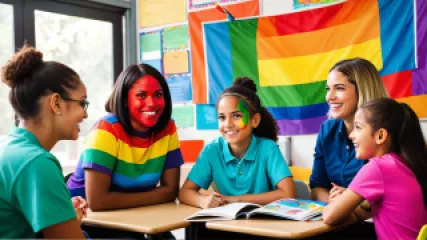How to Address Gender Roles in Education
In today's rapidly evolving society, addressing gender roles in education is more important than ever. The traditional concepts of masculinity and femininity have long influenced how students perceive themselves and others. This guide aims to provide a comprehensive approach to challenging these entrenched norms, fostering a more inclusive and equitable educational environment.
Understanding the Impact of Gender Roles in Education
Before diving into actionable steps, it's crucial to understand how traditional gender roles impact education. Gender roles dictate behaviors and expectations that can limit students' potential and affect their mental wellbeing.
For instance:
- Boys may feel pressured to excel in sports rather than academics.
- Girls might be steered away from subjects like math and science.
- Non-binary or gender-nonconforming students often face exclusion and misunderstanding.
These societal pressures can lead to imbalanced opportunities and emotional distress among students.
Step 1: Educate Yourself and Your Team
The first step in addressing gender roles in education is to educate yourself and your team. This means understanding the historical context of gender roles, recognizing current biases, and staying informed about best practices for promoting gender equality.
- Read extensively: Books, articles, and studies on gender roles can provide valuable insights.
- Attend workshops: Many organizations offer training sessions on gender inclusivity.
- Engage with experts: Consult with sociologists, psychologists, and educators who specialize in gender studies.
Remember: Ongoing education is key. This is not a one-time effort but a continuous process of learning and growth.
Step 2: Foster an Inclusive Curriculum
An inclusive curriculum is essential for challenging traditional gender roles. Here are some strategies to ensure your curriculum promotes gender equality:
- Integrate diverse perspectives: Include literature, history, and contributions from people of all genders.
- Use gender-neutral language: Avoid reinforcing stereotypes through language. For example, use "students" instead of "boys and girls."
- Highlight role models: Showcase achievements of individuals who defy traditional gender roles.
By incorporating these elements, you create a learning environment where all students feel represented and valued.
Step 3: Promote Critical Thinking
Encouraging critical thinking helps students question and challenge traditional gender roles. Here’s how to integrate critical thinking into your classroom:
- Facilitate open discussions: Create a safe space where students can express their views and learn from each other.
- Analyze media: Examine how books, films, and advertisements portray gender roles. Discuss the impact of these portrayals.
- Encourage debate: Organize debates on topics related to gender roles to help students articulate their thoughts and consider different perspectives.
This approach empowers students to think independently and develop a nuanced understanding of gender roles.
Step 4: Support Emotional Intelligence
Emotional intelligence (EI) is the ability to understand, manage, and express emotions effectively. Promoting EI in the classroom can help break down harmful gender stereotypes.
- Teach empathy: Use role-playing exercises to help students understand and share the feelings of others.
- Model emotional expression: Demonstrate healthy ways to express emotions, showing that it's okay for everyone to feel and show vulnerability.
- Provide resources: Offer materials on emotional intelligence and its importance in personal and professional life.
By fostering EI, you support students’ mental wellbeing and help them navigate the complexities of gender roles.
Step 5: Encourage Equal Participation
Ensuring equal participation in all activities is vital for challenging gender norms. Follow these tips to promote balanced involvement:
- Create mixed-gender groups: Organize group activities that require collaboration between all genders.
- Monitor participation: Keep track of who speaks up and participates. Encourage quieter students to contribute.
- Offer diverse activities: Provide a range of extracurricular options that appeal to different interests, breaking away from stereotypical choices.
These practices help create an inclusive environment where every student has the opportunity to succeed.
Step 6: Address Bias and Discrimination
Bias and discrimination can undermine efforts to challenge gender roles. It’s essential to address these issues head-on:
- Identify bias: Reflect on your own biases and encourage staff and students to do the same.
- Implement anti-discrimination policies: Establish clear guidelines and consequences for discriminatory behavior.
- Provide support: Offer counseling and support services for students who experience gender-based discrimination.
Creating a zero-tolerance policy for discrimination fosters a safe and supportive learning environment.
Step 7: Engage Parents and Community
Parents and the community play a crucial role in shaping students' perceptions of gender roles. Engaging them in your efforts can amplify the impact:
- Hold informational sessions: Educate parents about the importance of challenging traditional gender roles.
- Encourage involvement: Invite parents to participate in school activities and discussions about gender equality.
- Foster community partnerships: Collaborate with local organizations that promote gender inclusivity.
By involving parents and the community, you create a unified front against restrictive gender norms.
Step 8: Create a Gender-Inclusive Environment
A gender-inclusive environment is one where all students feel safe and supported, regardless of their gender identity. Here’s how to create such an environment:
- Design inclusive facilities: Ensure that restrooms, changing rooms, and other facilities accommodate all genders.
- Use inclusive imagery: Decorate classrooms and hallways with posters and materials that represent diverse gender identities.
- Adopt inclusive policies: Implement policies that protect and affirm the rights of gender-diverse students.
These measures contribute to a school culture that respects and values all gender identities.
Step 9: Evaluate and Adapt Your Approach
Continuous evaluation and adaptation are essential for sustained progress. Regularly assess the effectiveness of your initiatives and make necessary adjustments:
- Gather feedback: Solicit input from students, staff, and parents about your gender inclusivity efforts.
- Analyze data: Examine academic performance, participation rates, and wellbeing indicators across different genders.
- Adapt strategies: Use the insights gained to refine your approaches and address any gaps or challenges.
This iterative process ensures that your efforts remain relevant and effective over time.
The Role of Teachers in Challenging Gender Roles
Teachers are at the frontline of challenging gender roles in education. Their attitudes, behaviors, and teaching methods significantly influence students’ perceptions of gender. Here’s how teachers can make a difference:
- Lead by example: Model inclusive behavior and challenge gender stereotypes in your interactions.
- Provide diverse role models: Introduce students to a variety of role models from different genders and backgrounds.
- Encourage self-expression: Allow students to explore and express their gender identity without fear of judgment.
By taking these actions, teachers can create a more equitable and inclusive educational experience for all students.
The Importance of Gender Roles and Emotional Intelligence
There is a significant intersection between gender roles and emotional intelligence (EI). Traditional gender roles often discourage the development of EI, particularly in boys, who may be taught to suppress their emotions.
"Emotional suppression can lead to a range of mental health issues, including anxiety and depression. Encouraging emotional intelligence in all students is crucial for their overall wellbeing." Dr. Jasmine Casey, Psychologist
Therefore, integrating EI into the curriculum is vital for challenging harmful gender norms and supporting students’ mental health.
Gender Roles and Mental Wellbeing
Traditional gender roles can have a profound impact on mental wellbeing. Boys may feel pressure to conform to notions of toughness, while girls might struggle with societal expectations of passivity and nurturing. These pressures can lead to stress, anxiety, and other mental health issues.
Addressing gender roles in education involves creating a supportive environment where students can discuss their feelings and seek help when needed. Providing access to mental health resources and promoting a culture of openness are key steps in this process.
Gender Roles in Extracurricular Activities
Extracurricular activities often reflect traditional gender roles, with boys gravitating towards sports and girls towards arts or caregiving roles. To challenge these norms, it’s essential to:
- Encourage diverse participation: Motivate students to explore activities outside of traditional gender expectations.
- Highlight success stories: Share examples of individuals who have excelled in non-traditional roles.
- Create inclusive teams: Form co-ed teams and clubs to foster collaboration across genders.
These strategies help break down barriers and allow students to pursue their interests freely.
Addressing Gender Roles in STEM Education
STEM (Science, Technology, Engineering, and Mathematics) fields have historically been male-dominated. To promote gender equality in STEM education, consider the following steps:
- Provide mentorship: Connect students with mentors from diverse gender backgrounds who can offer guidance and support.
- Challenge stereotypes: Actively dispel myths about gender and aptitude in STEM subjects.
- Offer hands-on experiences: Create opportunities for all students to engage in STEM activities through clubs, competitions, and projects.
By implementing these measures, you can help close the gender gap in STEM and inspire a new generation of innovators.
Conclusion: A Collective Effort
Addressing gender roles in education is a complex but essential task. It requires the collective effort of educators, students, parents, and the community. By educating yourself, fostering an inclusive curriculum, promoting critical thinking, supporting emotional intelligence, encouraging equal participation, addressing bias and discrimination, engaging parents and the community, creating a gender-inclusive environment, and continuously evaluating your approach, you can make significant strides towards gender equality in education.
Ultimately, challenging traditional gender roles and promoting inclusivity benefits all students, allowing them to reach their full potential and contribute positively to society.
Remember, the journey towards gender equality in education is ongoing. Stay committed, stay informed, and continue to advocate for a more equitable and inclusive future for all students.






